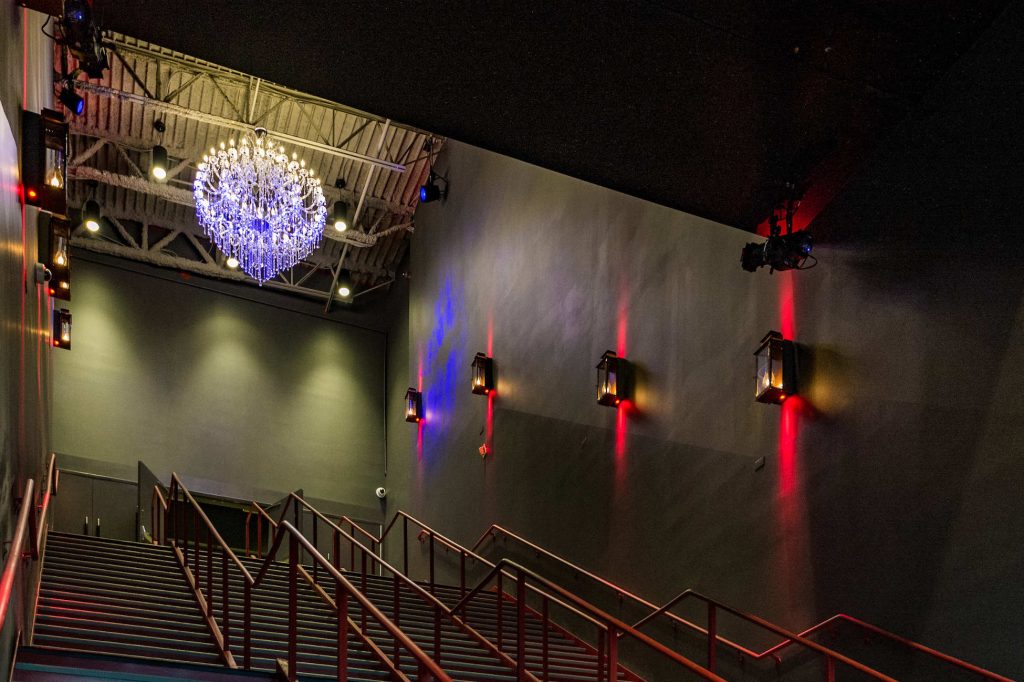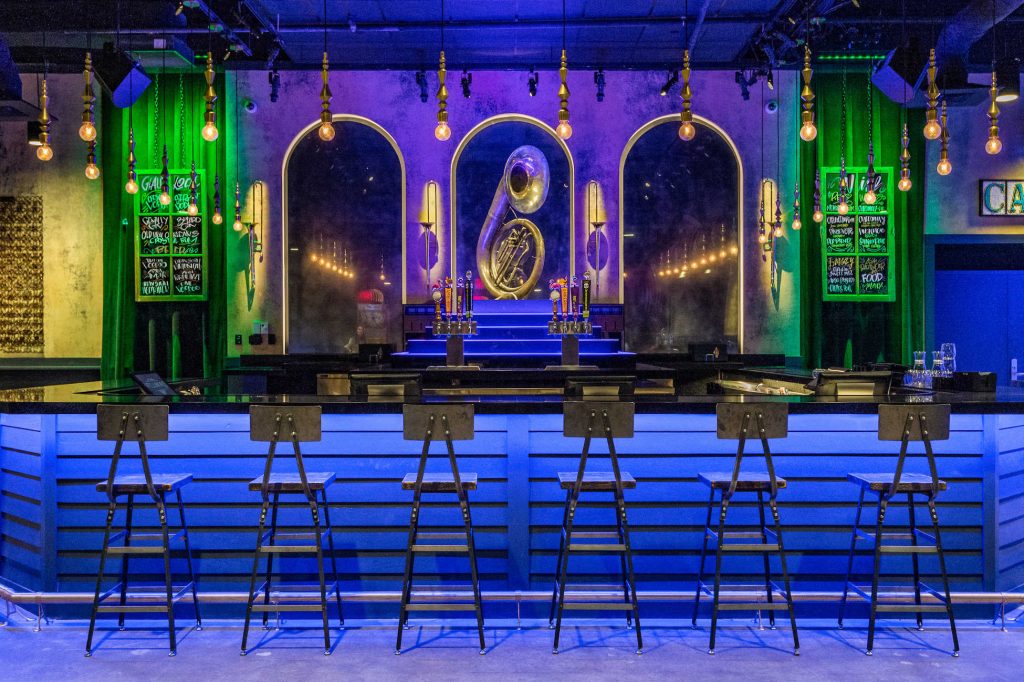The Fillmore New Orleans, a new live music venue on the second floor of Harrah’s Casino, features design elements that effortlessly blend San Francisco’s historic psychedelic 60s with the cultural archetypes of New Orleans.
Hundreds of fans queued up in front of the old-fashioned theater marquee on Canal Street last month not only to see Coheed and Cambria perform, but to celebrate the launch of New Orleans’ newest music venue, the Fillmore New Orleans. Live Nation, the world’s largest producer of live entertainment, has created this multi-million dollar facility, adding it to their growing Fillmore family of venues across the country. “We’ve spent a lot of time and money, I think more money than anyone else in the country, on designing these spaces that create memorable moments for our guests and for the bands who perform in our venues” says Ron Bension, Live Nation’s President of Clubs and Theaters.

Located on the second floor of Harrah’s Casino, the Fillmore New Orleans is a 22,000 square foot live entertainment venue that will hold up to 2200 fans, on par with other local venues like The Saenger and Mahalia Jackson. There are two bars at either side of the hall serving beer, specialty cocktails and food plus an area in the back with raised seating for approximately 1000 VIP and General Admission guests. But what makes the Fillmore New Orleans different from say the Fillmore Charlotte in North Carolina or the Fillmore Philly in Pennsylvania?
“I think it speaks to Live Nation’s vision that they don’t think of the Fillmore venues as a brand, they think of it as a family of music venues” says Craig Schmitt, Principal at Ewing Cole, the Philadelphia-based architectural and design company tapped for the project. “They don’t want it to have the same look and feel in every venue, as a chain brand would be, rather they want it to feel like it really belongs to that geographic location.” This proved to be a somewhat daunting undertaking considering the Fillmore New Orleans would be built out in what was essentially a featureless box, totally unlike the converted, century-old metals factory in Philadelphia or the historic textile mill in Charlotte.

“I think the key to any successful design project today is trying to draw out that sense of authenticity” says Ryan Leichtweisz, an architect at Ewing Cole who worked on the project. “The challenge for us was that we had a big white box with no existing character on the second floor of a casino.” To overcome this challenge, the team looked to the “local fabric of the city” and incorporated these elements “to make it feel like it was identify-ably New Orleans as possible.” Recycled clapboard siding was used to wrap a bar, wrought iron gates are used for merchandising, reclaimed mirrors display drink menus, a brassy sousaphone rotates above their “liquor altar” (an homage to our city’s cocktail culture) and trombones serve as light fixtures.
Ewing Cole’s design team also changed the structure of the space as well. Soaring ceilings were lowered almost 30 feet to create a greater sense of intimacy in the large venue. They also had to create a sort of sound barrier between the floor of the new space and the ceiling of the casino. “The entire music hall is raised up off of the existing floor (they call it an access floor) so it’s sort of like mini-stilts underneath panels,” explained Shannon Noon, Interior Designer with Ewing Cole. “There’s a whole false floor running through that entire space to make sure that sound doesn’t transfer down to the casino below.” Also, with the goal of perfecting the experience for both the performers and the fans being their ultimate goal, sightlines were improved in the standing-room only hall by incorporating tiered, raised platforms along the sides and fixed, stadium-like seating at the back.

In order to provide that true, authentically New Orleans experience, they sourced work from local artists and artisans in the venue’s design. Live Nation has its own small team of theater artists and craftsmen who can do everything from create one-of-a-kind murals to fabricate custom furniture. “Coincidentally, several of those artists reside right there in New Orleans, so they couldn’t have been more excited,” says Schmitt. “They usually have to get on a plane and travel to work and in this case it was in their own backyard.”
There are also works by other local artists featured in the space. Scott Guion, the man who created the New Orleans Jazz & Heritage Festival’s 2019 poster, also created a large mural of Louis Armstrong behind the front bar. “The Fillmore posters are such an iconic part of the background story of the Fillmore West, so we always tried to make sure that we tie in the posters in a way that honors them but also put a little bit of a spin on it,” says Noon. “The mural was painted over the top of a series of posters, so it’s really interesting. We just sort of gave him [Scott Guion] an idea and he ran with it.” In addition, signs for the bathrooms, tickets, Canal Street and more were created to look like New Orleans street tiles by local Mardi Gras bead artist Anna Walton, who also happens to be a 4th grade teacher. “We’ve featured some of her pieces on a really large scale” says Noon.
Weaving through design, there are subtle references to the original Fillmore West in San Francisco. From the iconic chandeliers to an entrance hall lined entirely with those unmistakable posters. “A lot of the kaleidoscopic colors that found their way into the Louis Armstrong mural, into the lighting schemes and some of the other design details are really meant to reference the history” Leichtweisz explained.

Likely one of the most dramatic areas of the New Orleans Fillmore is the voodoo-inspired VIP room. From the black, faux-alligator skin wall treatment and sultry lighting to the charred-wood bar and dripped wax, custom candelabra chandelier, BG’s Lounge took on a life of its own, separate from the main music hall. “Over the booths there’s large scale faces where you’re seeing just a little glimpse of an eye covered in a Mardi Gras mask,” says Leichtweisz. “So it’s a little bit sexy and seductive.”
Tucked in a niche behind some reclaimed doors, a Mardi Gras Indian costume on loan from the art warehouse at the House of Blues New Orleans gives guests another small glimpse into local culture which often can be highly adventurous, sensual and mysterious. “It’s like those beautiful courtyards that are tucked between houses,” says Noon. “All of a sudden, just because you turned your head one way, you get a peek of this whole, lush oasis in their backyard. If you were looking in a different direction, you would of missed it.”
*Photos courtesy of Frank Aymami Photography
*Article originally published in the March 2019 issue of New Orleans Living Magazine



